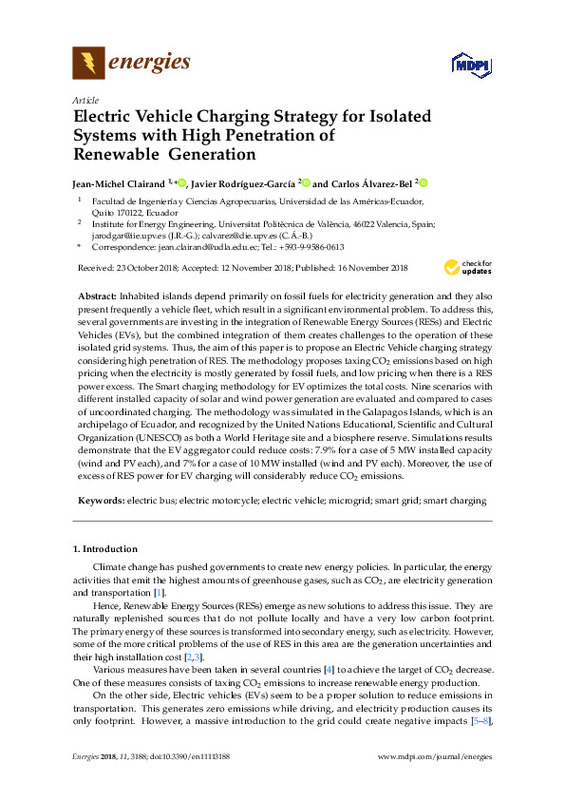JavaScript is disabled for your browser. Some features of this site may not work without it.
Buscar en RiuNet
Listar
Mi cuenta
Estadísticas
Ayuda RiuNet
Admin. UPV
Electric Vehicle Charging Strategy for Isolated Systems with High Penetration of Renewable Generation
Mostrar el registro sencillo del ítem
Ficheros en el ítem
| dc.contributor.author | Clairand-Gómez, Jean-Michel
|
es_ES |
| dc.contributor.author | Rodríguez-García, Javier
|
es_ES |
| dc.contributor.author | Álvarez, Carlos
|
es_ES |
| dc.date.accessioned | 2019-04-26T20:02:02Z | |
| dc.date.available | 2019-04-26T20:02:02Z | |
| dc.date.issued | 2018 | es_ES |
| dc.identifier.uri | http://hdl.handle.net/10251/119595 | |
| dc.description.abstract | [EN] Inhabited islands depend primarily on fossil fuels for electricity generation and they also present frequently a vehicle fleet, which result in a significant environmental problem. To address this, several governments are investing in the integration of Renewable Energy Sources (RESs) and Electric Vehicles (EVs), but the combined integration of them creates challenges to the operation of these isolated grid systems. Thus, the aim of this paper is to propose an Electric Vehicle charging strategy considering high penetration of RES. The methodology proposes taxing CO<mml:semantics>2</mml:semantics> emissions based on high pricing when the electricity is mostly generated by fossil fuels, and low pricing when there is a RES power excess. The Smart charging methodology for EV optimizes the total costs. Nine scenarios with different installed capacity of solar and wind power generation are evaluated and compared to cases of uncoordinated charging. The methodology was simulated in the Galapagos Islands, which is an archipelago of Ecuador, and recognized by the United Nations Educational, Scientific and Cultural Organization (UNESCO) as both a World Heritage site and a biosphere reserve. Simulations results demonstrate that the EV aggregator could reduce costs: 7.9% for a case of 5 MW installed capacity (wind and PV each), and 7% for a case of 10 MW installed (wind and PV each). Moreover, the use of excess of RES power for EV charging will considerably reduce CO2 emissions. | es_ES |
| dc.description.sponsorship | This research received no external funding. The APC was funded by Universidad de las Americas-Ecuador. | es_ES |
| dc.language | Inglés | es_ES |
| dc.publisher | MDPI AG | es_ES |
| dc.relation.ispartof | Energies | es_ES |
| dc.rights | Reconocimiento (by) | es_ES |
| dc.subject | Electric bus | es_ES |
| dc.subject | Electric motorcycle | es_ES |
| dc.subject | Electric vehicle | es_ES |
| dc.subject | Microgrid | es_ES |
| dc.subject | Smart grid | es_ES |
| dc.subject | Smart charging | es_ES |
| dc.subject.classification | INGENIERIA ELECTRICA | es_ES |
| dc.title | Electric Vehicle Charging Strategy for Isolated Systems with High Penetration of Renewable Generation | es_ES |
| dc.type | Artículo | es_ES |
| dc.identifier.doi | 10.3390/en11113188 | es_ES |
| dc.rights.accessRights | Abierto | es_ES |
| dc.contributor.affiliation | Universitat Politècnica de València. Departamento de Ingeniería Eléctrica - Departament d'Enginyeria Elèctrica | es_ES |
| dc.description.bibliographicCitation | Clairand-Gómez, J.; Rodríguez-García, J.; Álvarez, C. (2018). Electric Vehicle Charging Strategy for Isolated Systems with High Penetration of Renewable Generation. Energies. 11(11):1-21. https://doi.org/10.3390/en11113188 | es_ES |
| dc.description.accrualMethod | S | es_ES |
| dc.relation.publisherversion | http://doi.org/10.3390/en11113188 | es_ES |
| dc.description.upvformatpinicio | 1 | es_ES |
| dc.description.upvformatpfin | 21 | es_ES |
| dc.type.version | info:eu-repo/semantics/publishedVersion | es_ES |
| dc.description.volume | 11 | es_ES |
| dc.description.issue | 11 | es_ES |
| dc.identifier.eissn | 1996-1073 | es_ES |
| dc.relation.pasarela | S\377618 | es_ES |
| dc.contributor.funder | Universidad de las Américas, Ecuador |








